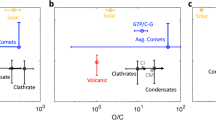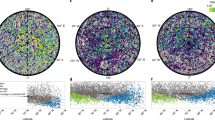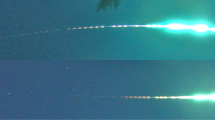Abstract
Shackleton crater is nearly coincident with the Moon’s south pole. Its interior receives almost no direct sunlight and is a perennial cold trap1,2, making Shackleton a promising candidate location in which to seek sequestered volatiles3. However, previous orbital and Earth-based radar mapping4,5,6,7,8 and orbital optical imaging9 have yielded conflicting interpretations about the existence of volatiles. Here we present observations from the Lunar Orbiter Laser Altimeter on board the Lunar Reconnaissance Orbiter, revealing Shackleton to be an ancient, unusually well-preserved simple crater whose interior walls are fresher than its floor and rim. Shackleton floor deposits are nearly the same age as the rim, suggesting that little floor deposition has occurred since the crater formed more than three billion years ago. At a wavelength of 1,064 nanometres, the floor of Shackleton is brighter than the surrounding terrain and the interiors of nearby craters, but not as bright as the interior walls. The combined observations are explicable primarily by downslope movement of regolith on the walls exposing fresher underlying material. The relatively brighter crater floor is most simply explained by decreased space weathering due to shadowing, but a one-micrometre-thick layer containing about 20 per cent surficial ice is an alternative possibility.
This is a preview of subscription content, access via your institution
Access options
Subscribe to this journal
Receive 51 print issues and online access
$199.00 per year
only $3.90 per issue
Buy this article
- Purchase on Springer Link
- Instant access to full article PDF
Prices may be subject to local taxes which are calculated during checkout


Similar content being viewed by others
References
Watson, K., Murray, B. C. & Brown, H. The behavior of volatiles on the lunar surface. J. Geophys. Res. 66, 3033–3045 (1961)
Arnold, J. R. Ice in the lunar polar regions. J. Geophys. Res. 84, 5659–5668 (1979)
Spudis, P. D., Plescia, J., Josset, J.-L. & Beauvivre, S. Geology of Shackleton Crater and the south pole of the Moon. Geophys. Res. Lett.. 36, L14201, http://dx.doi.org/10.1029/2008GL034468 (2008)
Nozette, S. et al. The Clementine bistatic radar experiment. Science 274, 1495–1498 (1996)
Stacy, N. J. S., Campbell, D. B. & Ford, P. G. Arecibo radar mapping of the lunar poles: a search for ice deposits. Science 276, 1527–1530 (1997)
Campbell, D. B., Campbell, B. A., Carter, L. M., Margot, J.-L. & Stacy, N. J. S. No evidence for thick deposits of ice at the lunar south pole. Nature 443, 835–837 (2006)
Simpson, R. & Tyler, G. L. Reanalysis of Clementine bistatic radar data from the lunar south pole. J. Geophys. Res. 104, 3845–3862 (1999)
Nozette, S. et al. Integration of lunar polar remote-sensing data sets: evidence for ice at the lunar south pole. J. Geophys. Res. 106 (E10). 23253–23266 (2001)
Haruyama, J. et al. Lack of exposed ice inside lunar south pole Shackleton crater. Science 322, 938–939 (2008)
Smith, D. E. et al. The Lunar Orbiter Laser Altimeter investigation on the Lunar Reconnaissance Orbiter mission. Space Sci. Rev. 150, 209–241 (2010)
Smith, D. E. et al. Results from the Lunar Orbiter Laser Altimeter (LOLA): global, high resolution topographic mapping of the Moon. Lunar Planet. Sci. Conf. XLII, 2350 (2011)
Mazarico, E. et al. Orbit determination of the Lunar Reconnaissance Orbiter. J. Geod. 86, 193–207 (2012)
Sun, X. et al. The Laser Ranging Subsystem on the Lunar Reconnaissance Orbiter. Report No. GSC-15884-1 (NASA New Technology Report, Washington DC, 2009)
Zuber, M. T. et al. The Lunar Reconnaissance Orbiter laser ranging investigation. Space Sci. Rev. 150, 63–80 (2010)
Neumann, G. A., Rowlands, D. D., Lemoine, F. G., Smith, D. E. & Zuber, M. T. Crossover analysis of MOLA altimetric data. J. Geophys. Res. 106 (E10). 23753–23768 (2001)
Thomson, B. J. et al. The interior of Shackleton crater as revealed by Mini-RF orbital radar. Lunar Planet. Sci. Conf. XLII, 1626 (2011)
Pike, R. J. in Impact and Explosion Cratering (eds Roddy, D. J., Pepin, R. O. & Merrill R. B., ) 489–509 (Pergamon, 1977)
Squyres, S. W. et al. Exploration of Victoria crater by the Mars Rover Opportunity. Science 324, 1058–1061 (2009)
Wilhelms, D. E., Howard, K. A. & Wilshire, H. G. Geologic Map of the South Side of the Moon (Map I-1162, US Geological Survey, 1979)
Ward, W. R. Past orientation of the lunar spin axis. Science 189, 377–379 (1975)
Howard, K. A. Fresh lunar impact craters — review of variations with size. In Proc. 5th Lunar Sci. Conf. 61–69 (Pergamon, 1974)
Pike, R. J. Depth/diameter relations of fresh lunar craters: revision from spacecraft data. Geophys. Res. Lett. 1, 291–294 (1974)
Hapke, B. Space weathering from Mercury to the asteroid belt. J. Geophys. Res. 106 (E5). 10039–10073 (2001)
Zimmerman, M. I. Farrell, W. M., Stubbs, T. J., Halekas, J. S. & Jackson, T. L. Solar wind access to polar craters: feedback between surface charging and plasma expansion. Geophys. Res. Lett.. 38, L19202, http://dx.doi.org/10.1029/2011GL048880 (2011)
Kwok, R., Cunningham, G. F., Zwally, H. J. & Yi, D. ICESat over Arctic sea ice: Interpretation of altimetric and reflectivity profiles. J. Geophys. Res.. 111, C06006, http://dx.doi.org/10.1029/2005JC003175 (2006)
Pieters, C. M. et al. Character and spatial distribution of OH/H2O on the surface of the Moon seen by M3 on Chandrayaan-1. Science 326, 568–572 (2009)
Gladstone, G. R. et al. Far-ultraviolet reflectance properties of the Moon’s permanently shadowed regions. J. Geophys. Res.. 117, E00H04, http://dx.doi.org/10.1029/2011JE003913 (2012)
Folkner, W. M., Williams, J. G. & Boggs, D. H. The Planetary and Lunar Ephemeris DE421 (Jet Propulsion Laboratory, Pasadena, 2008)
Pavlis, D. E., Poulouse, S. G. & McCarthy, J. J. GEODYN Operations Manuals (SGT, Inc., Greenbelt, 2009)
Mazarico, E., Lemoine, F. G., Han, S.-C. & Smith, D. E. GLGM-3, a degree-150 lunar gravity model from the historical tracking data of NASA Moon orbiters. J. Geophys. Res.. 115, E05001, http://dx.doi.org/10.1029/2009JE003472 (2010)
Williams, J. G., Boggs, D. H. & Folkner, W. M. Lunar Orbit, Physical Librations and Surface Coordinates (Jet Propulsion Laboratory, Pasadena, 2008)
Acknowledgements
The LOLA investigation is supported by the Lunar Reconnaissance Orbiter Mission under the auspices of NASA’s Exploration Systems Mission Directorate and Science Mission Directorate. We thank T. Perron for discussions.
Author information
Authors and Affiliations
Contributions
M.T.Z. led and participated in all aspects of the analysis and wrote the paper. J.W.H. oversaw the relative age dating analysis and participated in geologic interpretation of topography, slopes and roughness. D.E.S. led the acquisition and correction of the LOLA observations. G.A.N. led the slope and roughness analysis and contributed to the development of the topographic grid. E.M. performed refined orbit adjustments and led the analysis of illumination. A.R.T. and C.I.F. performed the crater counts used in the relative age date analysis. O.A. and M.A.R. contributed to the analysis and interpretation of slopes and roughness. H.J.M. contributed to the interpretation of the crater morphology in the context of Shackleton’s geological history and volatile sequestration.
Corresponding author
Ethics declarations
Competing interests
The authors declare no competing financial interests.
Supplementary information
Supplementary Information
This file contains Supplementary Text, Supplementary Table 1, Supplementary Figures 1-2 and additional references. (PDF 402 kb)
PowerPoint slides
Rights and permissions
About this article
Cite this article
Zuber, M., Head, J., Smith, D. et al. Constraints on the volatile distribution within Shackleton crater at the lunar south pole. Nature 486, 378–381 (2012). https://doi.org/10.1038/nature11216
Received:
Accepted:
Published:
Issue Date:
DOI: https://doi.org/10.1038/nature11216
This article is cited by
-
Laboratory measurements show temperature-dependent permittivity of lunar regolith simulants
Earth, Planets and Space (2023)
-
Theoretical analysis of the electric potential and the electrostatic dust transport around the Shackleton crater in the Lunar south pole region
Science China Earth Sciences (2023)
-
Illumination and regolith temperature at China’s next candidate lunar landing site Shackleton crater
Science China Earth Sciences (2023)
-
Derivation of 1.064 μm normal albedos on the C-type asteroid Ryugu from laser pulse intensity measurement of the Hayabusa2 LIDAR
Earth, Planets and Space (2022)
-
Experimenting with Mixtures of Water Ice and Dust as Analogues for Icy Planetary Material
Space Science Reviews (2019)
Comments
By submitting a comment you agree to abide by our Terms and Community Guidelines. If you find something abusive or that does not comply with our terms or guidelines please flag it as inappropriate.



